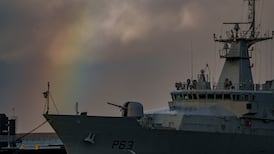Aviation has faced crises like this before, but there is no room for complacency, writes Gerry Byrne
Watching scenes of mayhem in Heathrow Airport yesterday morning, it was tempting to exclaim that air travel will never be the same again, that the security now demanded by airports and airlines will permanently rob aviation of its fading allure.
But, in fact, we've stared into this particular abyss before, and we're still flying. Not being able to bring aboard a baby's bottle, a paperback or duty-free booze and perfume might seem like the end of the world, but we've faced similar hardships before.
After September 11th it was nailfiles, after Lockerbie it was radio-cassette players, and both scares reflected the modus operandi of the terrorists involved.
The advent of the suicide-bomber has considerably upped the ante. All previous air security measures assumed that a hijacker would not want to die with his victims. Now we face a situation where a bomber can assemble his bomb nonchalantly from the contents of innocuous domestic containers, then trigger it to explode, taking him and hundreds of his flying companions to their deaths.
However, it is perhaps perversely reassuring to note that in Europe you are still safer from terrorists travelling by air than by train.
Since September 11th there have been no air deaths caused by terrorism in the EU while train, bus and underground passengers have been less fortunate. Some 200 died in the Madrid train bombings and another 50 in last year's London bus and Tube bombs.
Yet there is no room for complacency. Even before yesterday's "liquids" scare, EU aviation was already in the throes of a low-level security crisis, which meant that passengers on flights arriving from Luton, Copenhagen and Budapest airports have to be segregated from other passengers "airside" (after check-in for departures, and pre-customs for arrivals).
In Dublin this has, for example, led to the unusual sight of Ryanair passengers coming from Luton being processed via Pier C at Dublin, rather than Ryanair's preferred Pier A. In Pier A, incoming and outgoing passengers are able to mingle. Not so in Pier C.
Those three airports all dramatically failed surprise EU safety audits to the extent that they have been the subject of a rare so-called Section 15 sanction whereby their passengers are not allowed to mix airside with passengers destined for other destinations on arrival in another country.
The fear is that a terrorist could smuggle banned materials aboard at, say, Luton, and pass them to accomplices airside in, for example, Pier A in Dublin, to be loaded on to another flight.
Lest we congratulate our own security too much, it should be remembered that Dublin airport in April 2005 also failed one of these safety audits, although never to the extent that its passengers were segregated as potential security risks elsewhere. Dublin reassuringly passed a more recent audit with more or less flying colours. We should always remind ourselves of the stark, discomforting fact that most modern security measures are merely playing catch-up with the terrorists' latest tricks.
Prior to the advent of the suicide-bomber, none was more chilling than the "double-switch" mechanism used in the radio-cassette bomb aboard the doomed Boeing 747 which came down at Lockerbie, Scotland, in December 1988, killing all 255 aboard and 11 on the ground.
That flight originated in Frankfurt, then landed in London, where the Libyan bomber left the flight. His luggage, containing the bomb, remained on board. It contained a trigger, which would fire when the aircraft reached cruising altitude for the second time, and it did this over Lockerbie.
The tragedy of Lockerbie is that airport security personnel throughout Europe already had been briefed on the existence of this new type of bomb, but the security measures needed to combat it had not yet been put in place.
Yesterday's scare was reassuring to the extent that at least a Lockerbie-style security lapse is much less likely, but that must be offset against the almost certain knowledge that somewhere terrorists are already refining the tools of their next outrage.
It makes it more imperative that airport security maestros, instead of waiting for another shoe-bomber to stroll along, should instead be attempting to think like terrorists and forecast what they are likely to try next. Should it not have occurred to someone long before that it is possible to disguise plastic explosives inside domestic containers? Or that two or three apparently innocuous everyday materials, undetectable by current measures, might be mixed aboard an aircraft to produce a deadly incendiary bomb?
So what does this mean for air travel in the years ahead? Relatively little, if September 11th is any guide. Despite watching many die on TV that day, people still returned to flying in huge numbers.
This time, thankfully, real long-lasting horror was avoided, although the impact on airline economics might be significant in the short term.
Ryanair and the other budget carriers recently had discovered how profitable it was to charge their customers for checked-in baggage while encouraging "free" cabin luggage.
The International Civil Aviation Organisation, a UN agency, and US flight attendants have been almost alone in warning about the dangers of this trend (most US aviation injuries are caused not by crashes, but by heavy bags tumbling out of overhead lockers).
So, in more ways than one, yesterday's developments have made aircraft cabins safer.
• Gerry Byrne is an aviation journalist and author









